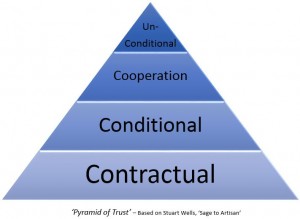 Trust is a core component of any relationship. Whether this is a romantic partner, voluntary group or team in a busy working environment. Trust has to be earned slowly over time and unfortunately, there is no short cut to building trust with others.
Trust is a core component of any relationship. Whether this is a romantic partner, voluntary group or team in a busy working environment. Trust has to be earned slowly over time and unfortunately, there is no short cut to building trust with others.
Belbin team roles, Myers Briggs and other assessment tools help us understand the individuals within a team but trying to get a group of people to trust each other and align to a common purpose or objective can be very challenging.
When you have two or more people working together there are many opportunities for disagreement, friction and conflict. Mistrust can creep in slowly and if unresolved, these problems can destroy your team. Trust is foundational and is required to be developed between team members. It is the emotional glue that sticks the team together in times of trouble and high stress, prevalent in today’s modern workplace.
Pat Lencioni in his book, ‘The 5 Dysfunctions of a team’, describes the ‘Absence of Trust’ as the foundational element of every failed team. In the ‘Drexler/ Sibbet Team Performance Model’ they describe trust building as a key component in high performing teams. Shortly after a new team is formed then Trust Building is the first building block. The individuals need to build trust and then build interdependences with each other. They need to understand who they are and why they are in the team, develop mutual respect, trust and faith in each other. Only after this step is completed can the team move on, if this foundational point is missing then the team will fail as the ‘Pyramid of Trust’ collapses.
How do we define trust, build trust and more importantly, how do we go about measuring it?

This pyramid has helped me to define the levels of trust within the teams I have observed. It provides a common measure and vocabulary to describe the trust within a team or group of individuals. It is a quick way to measure trust and should help you define clear steps to help drive you and your team to the top of the pyramid and a high performing team.
Contractual – This is the lowest level of trust. Here the team members rely on rules and company policy manuals. Individuals may frequently refer to their ‘job title’ or ‘job description’. You may hear them say, ‘its not my job’. They may refer to contractual arrangements ‘I should be at work at 9am and leave at 5pm.’ Individuals may refer to their employee rights and union or works council agreements. Email correspondence increases as face to face communication decreases. Cc list increases and more senior people are added into the email thread to become more political and drag others from the team and outside of team into the discussion. If everyone aligns to the contract then the team can function.
Conditional – The individuals tolerate each other and build verbal agreements, ‘if you do this, I will do that’. Unwritten contracts and agreements are established and if all conditions are met then the team will function. The members will cooperate as long as both parties complete their end of the bargain. The share of work and responsibility has to be equal and be fair. There is some form of unity and teamwork but it always has conditions attached.
Cooperative – Everyone works together. There are small problems and disagreements however, the team rolls over the bumps easily. Some minor problems appear especially if the team are passionate about their goals. The team are now at the norming stage and achieving objectives. Individual needs are being met and there is a fair and equal distribution of workload in relation to the skill sets and responsibility within the group. If the objectives are met and all accomplish and receive their fair share of the ‘reward’ then there is good cooperation.
Un-Conditional – Total trust has been established and now all members know that they win or lose as a team. Some individual may take on more than their fair share but they understand and respect the strengths and skills of the others. All team members know their value and place in the team. Email traffic decreases or is minimal as team use more face-to-face communications and phone. Members of the team will ‘cover’ for other team members if there is a problem and protect the reputation of the individual and team. Team members will help each other without regard for their own personal agendas. The team are now more like a family or a community, the team’s success comes first and everyone wins together.
You are now at the top of the pyramid with total trust. It is a great place to be and as a team member or leader your responsibility is to continue trusting and continue building and more importantly, watch out for the early signs that trust may be degrading.
Keep pushing up the pyramid…
Stuart
Making Steps and Leaving Footprints…
